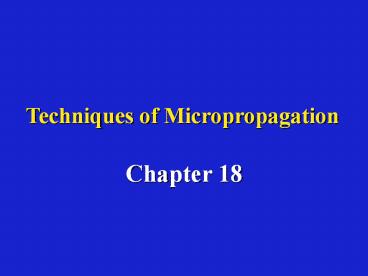Techniques of Micropropagation - PowerPoint PPT Presentation
Title:
Techniques of Micropropagation
Description:
Techniques of Micropropagation – PowerPoint PPT presentation
Number of Views:1921
Avg rating:3.0/5.0
Title: Techniques of Micropropagation
1
Techniques of Micropropagation
- Chapter 18
2
Systems used to regenerate plantlets by
micropropagation
- I.) Axillary shoot formation
- Meristem tip culture
- Results in plantlets free from viruses, fungi and
bacteria (esp. when coupled with heat treatment) - Important for many herbaceous crops (carnations,
mums, orchids, geraniums, banana, potato,
sweetpotato) - With woody plants, meristems are often grafted
- Axillary shoot culture
- Reliably reproduces the genotype of the parent
plant (expands existing buds)
3
Carnation meristem
4
Nodal shoot production at cotyledonary stage
5
Systems used to regenerate plantlets by
micropropagation
- Adventitious shoot formation
- Initiated directly on the explant or indirectly
from callus - Results in high rates of multiplication
- Results in increased aberrant (off-type) plants
- Parts used
- Leaf pieces (ie African violet)
- Cotyledons (ie conifers)
- Immature inflorescence (ie Hosta and daylily)
- Bulb scales (ie Easter lily, hyacinths, etc.)
6
Bulblet formation in tissue culture
7
Hosta culture
8
Hosta culture
9
Hosta culture
10
Types of micropropagation
11
(No Transcript)
12
Systems used to regenerate plantlets by
micropropagation
- III.) Callus, cell protoplast culture systems
- Can be subcultured and maintained indefinitely
- Callus culture
- Produced in response to wounding hormones
- Almost all plant parts can be induced to produce
callus - Both auxins cytokinins must be in the medium
- Can be induced to form organs (Organogenesis).
Parenchyma produces meristems ( meristmoids) - First done with tobacco carrot
13
(No Transcript)
14
(No Transcript)
15
(No Transcript)
16
Direct shoot production (organogenesis)
17
Systems used to regenerate plantlets by
micropropagation
- Cell suspensions
- Produced from friable callus ( loose)
- Maintained in shaker cultures or bioreactors
- Protoplast culture
- Cell culture without cell walls (cellulase added
to degrades the cell wall) - Only plasmamembrane remains
- Osmotic pressure must be maintained to keep cells
from rupturing (mannitol used) - Why done? Secondary plant products that leak from
the protoplasts are collected (ex taxol,
sanguinaria)
18
Cell cultures on a shaker
19
Bioreactors for cells or protoplasts
20
Protoplast culture
21
Protoplast culture
22
(No Transcript)
23
(No Transcript)
24
Sanguinaria canadensisbloodroot
25
Systems used to regenerate plantlets by
micropropagation
- IV.) Somatic embryogenesis Synthetic seed
- Development of embryos without a zygote (i.e.
from non-gamete cells) - Roots and shoots develop simultaneously to form
embryoids (i.e. carrots)
26
Systems used to regenerate plantlets by
micropropagation
- Arise from
- Adventitious somatic embryogenesis (directly from
cells embryogenic cells). Usually arise near
zygotic cells - Induced somatic embryogenesis. Callus must form
first (often in suspension culture). Usually
conditioned on high levels of auxin (2,4-D) - Uses
- Clonal propagation
- Genetic manipulation -using Agrobacterium
tumefasciens or a gene-gun
27
Somatic embryogenesis (soybean)
28
Somatic embryogenesis (soybean)
29
Somatic embryogenesis (sitka spruce)
30
Systems used to regenerate plantlets by
micropropagation
- Environmental conditions during tissue culture
- Temperature
- 68 - 81F
- Often held constant to reduce condensation but
bulb crops prefer alternating temperatures - Cultures can be refrigerated to slow growth and
reduce subculture frequency
31
Systems used to regenerate plantlets by
micropropagation
- Light
- Irradiance 40 - 80 umolm-2sec-1 at culture
level (in a greenhouse the irradiance levels
range from 600 - 1200 umolm-2sec-1 ) - Remember cultures are heterotrophic, therefore
high light for photosynthesis is not critical.
High sucrose levels and low CO2 levels inhibit
photosynthesis
32
Systems used to regenerate plantlets by
micropropagation
- Photoperiod typically 12 - 16 hours
- Light quality typically cool-white fluorescent
lamps used - Vessel and lid effects light quality reaching the
culture - Incandescent (red) light increases shoot
elongation - Fluorescent (blue) light reduces shoot elongation
33
Systems used to regenerate plantlets by
micropropagation
- Gases
- O2, CO2 and C2H2 all affect the culture
- Problems in tissue culture
- Hyperhydricity (vitrification)
- Water-soaked appearance from excess cell water
- Leads to culture deterioration
- Remedy change agar type and concentration,
reduce condensation/free water
34
(No Transcript)
35
(No Transcript)
36
Hepa filters over vents on lids reduce
condensation and improve gas exchange
37
Systems used to regenerate plantlets by
micropropagation
- Internal pathogens- especially bacteria (can
culture on a medium containing an antibacterial
agent) - Release of phenolics (causes blackening of the
medium). Can be controlled by adding activated
charcoal to the medium - Tissue proliferation (TP)
- Gall-like growths on micropropagated plants
(especially rhododendrons)
38
(No Transcript)
39
(No Transcript)
40
(No Transcript)
41
(No Transcript)
42
(No Transcript)
43
(No Transcript)
44
(No Transcript)
45
Systems used to regenerate plantlets by
micropropagation
- Habituation
- Cultures (shoots) continue to proliferate even
when moved to a medium without growth regulators - Variation in micropropagated plants
- Increased vigor - not known why
- Increased branching - in herbaceous plants
especially - Genetic variation - especially of chimeric plants
like Hosta
46
(No Transcript)
47
Stabilization of cultures
48
Determining the proper amounts of cytokinins
49
Determining the proper amounts of cytokinins
50
Peony embryo excision and placement in tissue
culture
51
Chionanthus virginicus embryo excision and
placement in tissue culture
After 2 years from TC
Growth after 2 years from seed
52
Micrografting
53
Problems in tissue culture
Lack of epicuticular waxes
Phenolic build-up in medium
54
Problems in tissue culture
Difficulties in shoot production in Gymnocladus
dioicus kentuky coffeetree
55
Sources for supplies/info.
- http//aggie-horticulture.tamu.edu/tisscult/microp
rop/microprop.html
Storage of culture in refrigeration

